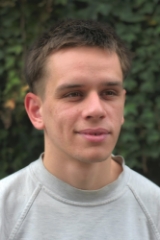SNSF Image Competition
Images from cancer research and archaeology selected
Lucien Hinderling and Guido Schreurs, two researchers from the University of Bern, have received a prize and a distinction respectively in the 2025 Scientific Image Competition of the Swiss National Science Foundation (SNSF).

Two researchers from the University of Bern demonstrated their eye for pictures in the Scientific Image Competition organized by the Swiss National Science Foundation (SNSF): With his photo, Guido Schreurs won first place in the Women and Men of Science category and Lucien Hinderling’s video loop won a distinction in the “Video loops” category.
Bucket acts as a link
Guido Schreurs, Professor of Geology at the University of Bern, discovered his passion for photography years ago. Back in 1999, he presented analogue black-and-white photographs in a specialist library at the University of Bern. He is now delighted that his prize-winning picture will be exhibited as part of the Biel Festival of Photography, as will all the winning works from the Scientific Image Competition. When he read the call for tenders, he immediately thought of the photographs he had taken in a memorable moment in Teniky, in southern Madagascar.
“It was early in the morning and chilly. The lighting conditions were impressive. Our research team was standing at the foot of a steep cliff, and I was a little out of the way in the shade and spontaneously decided to photograph the scenery.” The picture captures a moment when a large heap of earth had to be relocated. “I like how the approximately 20 people in the shadow in the foreground form a chain of people and pass on the full buckets in good spirits,” says Schreurs. In their commentary, the jury described the bucket “as a link” between people.
«Our research team was standing at the foot of a steep cliff, and I was a little out of the way in the shade and spontaneously decided to photograph the scenery.»
Guido Schreurs
Schreurs is still fascinated by Teniky. Accordingly, he will return to the excavation site for further work with researchers this year. He currently suspects that the settlement by Zoroastrians from Iran took place around 1,000 years ago. Thousand-year-old charcoal fragments unearthed at the site allow for this chronological classification. “I’m fascinated by this almost mysterious place because it raises a lot of unanswered questions,” says the geologist. The settlers of Teniky cut niches and chambers into the rock faces that are unique in Madagascar and the southwest Indian Ocean. But it seems that the settlers of the time did not live in Teniky for long. This, too, remains an unsolved mystery.
“Choreography of migrant tumor cells” by Lucien Hinderling: The epithelial cells in cancer move in complex formations. Video: CC BY-NC-ND
Lucien Hinderling, a doctoral student at the Institute of Cell Biology at the University of Bern, impressed the jury enough to win a distinction. The movements of cancer cells in his video loop “give a strange grace to an often fatal disease,” comments the jury. Hinderling himself says: “My imagery is intended to underline the importance of experimental research in clarifying relevant processes.” This is because moving images can lead to a better understanding of cancer. The co-creators of the video loop are Agne Frismantiene and Olivier Pertz from the University of Bern.
Artistic view of research
The award-winning video loop shows that cancer cells are dynamic and exhibit complex behavior. It becomes clear how the epithelial cells form patterns. The cells are human breast cells with the genetic mutation PI3K, which is often seen in cancer.
Hinderling developed real-time microscopy platforms for his way of imaging. Optogenetics – a method in which cells are selectively activated or deactivated by light pulses – and computer control, which precisely controls these light signals, can be used to study dynamic cellular signal transmission, i.e. the time-varying communication and response of cells to stimuli.
«My imagery is intended to underline the importance of experimental research in clarifying relevant processes.»
Lucien Hinderling
Hinderling is passionate about research. “I find it very satisfying to pursue things that intrigue me,” says the doctoral student. He is fascinated by discovering new perspectives on research and communicating them to the public. His dynamic research images are almost artistic in nature. “I intend to continue combining research with aesthetic video recordings in the future.”
More about the SNSF Image Competition
Every year since 2017, the Swiss National Science Foundation (SNSF) has invited scientists to present their research in a photograph or video. The Scientific Image Competition is aimed at all researchers working at a university or other research institution in Switzerland or Liechtenstein. Works can be submitted in four categories: “Object of study,” “Locations and instruments,” “Women and men of science,” and “Video loops”. The winning works will be exhibited at the Biel Festival of Photography from May 2 to 25, 2025.
Personal information

Guido Schreurs
Guido Schreurs studied geology at the University of Utrecht in the Netherlands and received a PhD from ETH Zurich. He has been an associate professor at the Institute of Geology at the University of Bern since 2013. As a geologist, he has worked in many regions of Madagascar and headed up several research projects there.
Zur Person

Lucien Hinderling
Lucien Hinderling studied computer science at the University of Fribourg, where he was particularly interested in the application of computer vision in biological research. After completing an MSc in bioinformatics, he began his PhD at the Institute of Cell Biology at the University of Bern in the laboratory of Prof. Olivier Pertz.
